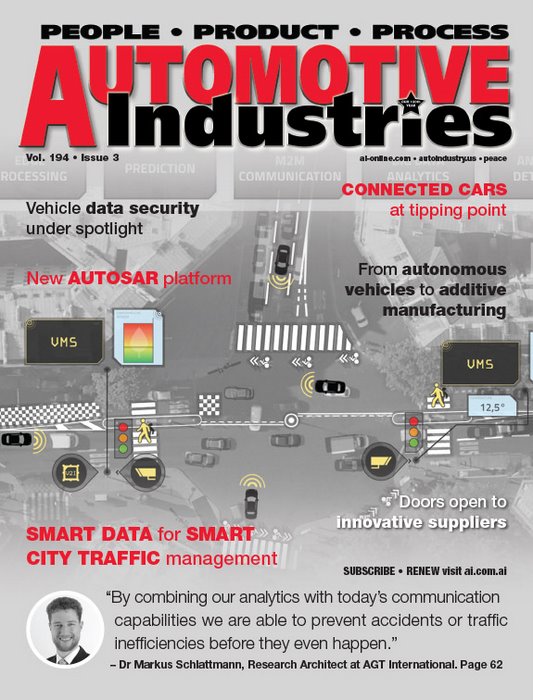
A key determinant of the quality of life of people living in cities is the way the traffic is managed. The advent of intelligent sensors and connected vehicles gives city managers a completely new set of tools.
A key determinant of the quality of life of people living in cities is the way the traffic is managed. Hours spent in traffic jams or working days lost due to injuries sustained in road accidents not only affect the quality of life – they have a direct impact on the competitiveness of a city.
Well-managed transport systems increase the appeal of cities to investors and entrepreneurs in an increasingly competitive global business environment.
Automotive Industries (AI) asked Dr Markus Schlattman, Research Architect at AGT International, how data can be used to better manage road usage.
Schlattman: Traffic is one of the most IoT data intensive fields we have today and various applications (e.g. as part of V2V or V2I) are emerging. Most of those applications just provide particular views of a small subset of the data itself. At AGT we focus both on Big Data technologies and advanced IoT analytics to really make sense of the very heterogeneous and vast amounts of data coming from real world sensors. The Smart Intersection is an example of how a set of sensors combined with advanced analytics and connectivity can support citizens in their daily life and can increase cities’ attractiveness.
AI: What role does AGT’s Smart Intersection play in helping cities deal with traffic issues?
Schlattman: Using advanced video analytics we’ve enabled the smart intersection to optimize traffic flow and increase safety for different road users. Our key technologies are intelligent and dynamic traffic lights to make pedestrian crossing more efficient and support minorities, prediction of dangerous road situations to avoid accidents and detection of abnormal traffic incidents to decrease reaction times of traffic forces. One important factor of our solutions is to ensure privacy for people. Therefore, we process the video and data directly at the smart intersection.
AI: How can advanced video analytics combined with machine learning technologies and new generations of smart connected devices be used for smart traffic management? Schlattman: The combination of video analytics with machine learning enables us to achieve more intelligent algorithms that are able to self-adapt to specific situations and to distinguish automatically which situations are abnormal, leading to potential danger. By combining our analytics with today’s communication capabilities we are able to prevent accidents or traffic inefficiencies before they even happen. For example, a direct channel to a smart car can bring up an in-car alarm of a predicted collision with a bike.
AI then asked Dr Manuel Görtz, Senior Researcher and Project Manager at AGT, what role the company had played in the PeerEnergyCloud (PEC) initiative.
Görtz: The complete process chain (sensor data gathering, data processing on smart home gateway, secure communication to the backend, analysis and storage of energy data, and providing of a web app) was developed and provided by AGT.
AI: How did that initiative lead into the current role AGT is playing in the European Union’s Horizon 2020 Lighthouse Projects?
Görtz: AGT’s expertise in the area of analytics for traffic and energy has played a vital role inviting AGT to the GrowSmarter partner selection process. Additionally, the results achieved in PEC showed AGT’s ability to execute cutting-edge research projects. In GrowSmarter, a European Smart City lighthouse project, AGT will build upon its work accomplished in PEC and will enhance it to serve up to 1,400 homes in the Stegerwaldsiedlung in Cologne. AI: What are some of the challenges in IoT in terms of collating and analyzing data?
Görtz: Applying standard big data analytics to IoT isn’t very effective due to the unique nature of IoT data. IoT data demands analytics specifically designed for the new IoT data created when millions of new sensors and devices become connected and start to interact.
Over the past six years AGT has delivered IoT deployments for customers worldwide including smart cities, water infrastructure management, energy management, traffic management, critical asset management and large-scale event management. Our deep expertise in sensor data management, advanced analytics and visualization turn big IoT data into relevant data.














More Stories
LED Lighting for Heavy-Duty Applications: Durability, Efficiency, and Versatility
Celanese Materials Shine in Multiple Category Winners at 2024 SPE Automotive Innovation Awards
New future-ready single-slot PXIe controller for high-performance T&M applications from Pickering Interfaces